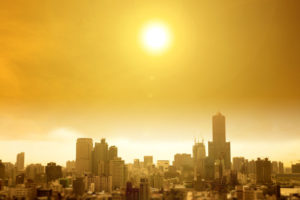 Who hasn’t sweltered while walking down a city street in the summertime? Have you ever found yourself wondering if it’s actually hotter there, or if it’s just a trick of the mind? You’re not alone (and you’re not wrong)! Cities are, in fact, often hotter than country settings because of a phenomenon called the urban heat island effect.
Who hasn’t sweltered while walking down a city street in the summertime? Have you ever found yourself wondering if it’s actually hotter there, or if it’s just a trick of the mind? You’re not alone (and you’re not wrong)! Cities are, in fact, often hotter than country settings because of a phenomenon called the urban heat island effect.
What Are Urban Heat Islands?
Like the name implies, cities (and industrial areas) often become islands of heat – meaning that they’re hotter than nearby rural areas. According to the U.S. Environmental Protection Agency (EPA), “The annual mean air temperature of a city with 1 million people or more can be 1.8–5.4°F (1–3°C) warmer than its surroundings. In the evening, the difference can be as high as 22°F (12°C).”
What Causes Urban Heat Island Effect?
Ultimately, the temperature difference between an urban environment and a rural one has to do with how the surfaces in each absorb and retain heat. The grass, plants, and trees found in rural areas help to maintain a more balanced temperature – a benefit that’s lost when there’s an imbalance in the ratio of manmade infrastructure versus natural landscapes. Instead, the cement, asphalt, brick, steel, and roofing materials used to create sky rises, roads, sidewalks, parking lots, and other infrastructure absorb and trap the sun’s heat – keeping the area hotter even as the evening temperatures fall.
Additionally, a massive population in a compact area creates substantial “waste heat” – or the byproduct of human activity. Some of this comes directly from the human body (think of how it feels in a packed elevator), but most waste heat is created by the tools we use – like vehicles, HVAC systems, construction equipment, etc.
What Is the Impact?
The EPA points to two major concerns resulting from urban heat island effect:
- Energy Implications
- Public Health Risks
Higher urban temperatures mean greater demand for air conditioning – which, in turn, means higher energy demands. So, not only does this mean higher utility bills, but it also contributes to reduced energy efficiency (and increased environmental impact).
Urban heat islands commonly experience poor air quality, and the impact of extreme heat events are magnified – both of which pose serious public health risks. This is especially true in lower-income neighborhoods, where residents are less likely to have access to air conditioning.
How Can Tensioned Membrane Architecture Help?
The building industry is constantly looking for new ways to achieve more energy efficient architecture, and more architects are turning to architectural shading solutions for passive cooling options. Tensioned membrane architecture (including free-standing tension structures and tensile facades) are one of the most dynamic and cost-effective solutions.
Especially when using lighter colors, the innovative membranes used in this type of architecture reflects much sun’s heat-inducing UV rays – reducing the impact of solar heat gain on a building and urban heat island effect on a community.
Explore some of the creative ways tensioned membrane architecture is being used to support energy efficiency goals:
- Maximizing The 5th Facade: Tensile Membrane Facades & Your Project’s Rooftop
- Reduce Environmental Impact & Waste Contributions with Tensile Fabric Structures
- Energy Efficient Architecture: Transforming People into the Solution (Not Just the Problem)
Are Tension Structures & Tensile Facades Right for Your Urban Project?
In the Tension Structures Division of Eide Industries, we specialize in design, engineering, manufacturing, and installation of structurally complex and creatively challenging commercial, government, and prototype design projects. We provide expertise and support for architects, landscape designers, general contractors, and property owners to develop their custom tensile membrane project ideas and construct iconic structures.
Explore the options for your next project. Contact one of our experts today by calling 800-422-6827.
